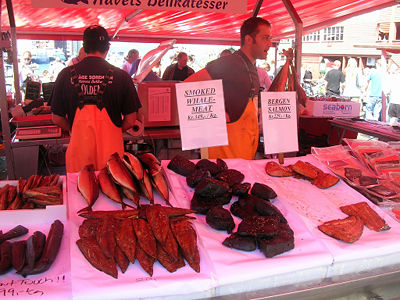Whaling: Difference between revisions
imported>John Stephenson (forgot Iceland...) |
imported>Richard Jensen (add text and bibl) |
||
| Line 1: | Line 1: | ||
{{subpages}} | {{subpages}} | ||
[[Image:Bergen-market.jpg|right|thumb|400px|{{#ifexist:Template:Bergen-market.jpg/credit|{{Bergen-market.jpg/credit}}<br/>|}}Whale meat and fish on sale at a market in | [[Image:Bergen-market.jpg|right|thumb|400px|{{#ifexist:Template:Bergen-market.jpg/credit|{{Bergen-market.jpg/credit}}<br/>|}}Whale meat and fish on sale at a market in Bergen, Norway.]] | ||
'''Whaling''' refers to the | '''Whaling''' refers to the hunting of [[whale]]s for their blubber (meat) and oil. Today, whaling remains part of the cultures of [[Japan]], [[Norway]] and [[Iceland]], and in addition some aboriginal communities also hunt whales. | ||
==History, U.S. and Canada== | |||
American whaling's origins were in New England, especially Cape Cod, Massachusetts and nearby cities. The oil was in demand chiefly for lamps. Hunters in small watercraft pursued right whales from shore. By the 18th century, whaling in Nantucket had become a highly lucrative deep-sea industry, with voyages extending for years at a time and with vessels traveling as far as South Pacific waters. During the [[American Revolution]], whaling went into an economic downswing, just like other American blue-water enterprises. In the 1780s, the industry began to prosper, using bases on the mainland such as New Bedford. Whalers took greater economic risks to turn major profits: expanding their hunting grounds and securing foreign and domestic workforces for the Pacific. Ultimately, American entrepreneurs created a mid-nineteenth-century version of a global economic enterprise. This was the golden age of American whaling. From the Civil War through the early twentieth century, the American whaling industry—faced with new, crippling economic competition at home and overseas, along with diminishing numbers of whales—spun towards extinction.<ref> Dolin (2007)</ref> | |||
Whale hunting became an important industry in [[Newfoundland and Labrador]] around 1900. At first slow whales were caught by men hurling harpoons from small open boats. Mechanization copied from Norway brought in cannon-fired harpoons, strong cables, and steam winches mounted on maneuverable, steam-powered catcher boats. They made possible the targeting of large and fast-swimming whale species that were taken to shore-based stations for processing. The industry was highly cyclical, with well-defined catch peaks in 1903–05, 1925–30, 1945–51, and 1966–72, after which world-wide bans shut it down.<ref> Anthony B. Dickinson and Chesley W. Sanger, ''Twentieth-Century Shore-Station Whaling in Newfoundland and Labrador'' (2005).</ref> | |||
==History, Japan== | |||
==History, Norway and Iceland== | |||
==International politics== | |||
==Bibliography== | |||
* Andrews, Roy Chapman. ''All About Whales.'' (1954). | |||
* Dolin, Eric Jay. ''Leviathan: The History of Whaling in America'' (2007) 480 pp. [http://www.amazon.com/Leviathan-History-Eric-Jay-Dolin/dp/0393060578/ref=sr_1_2?ie=UTF8&s=books&qid=1207596886&sr=8-2 excerpt and text search] | |||
* Stoett, Peter J. ''The International Politics of Whaling'' (1997) [http://www.questia.com/read/57120862?title=The%20International%20Politics%20of%20Whaling online edition] | |||
* Webb, Robert Lloyd. ''On the Northwest: Commercial Whaling in the Pacific Northwest, 1790-1967'' (1988) [http://www.questia.com/read/98023943?title=On%20the%20Northwest%3a%20Commercial%20Whaling%20in%20the%20Pacific%20Northwest%2c%201790-1967 online edition] | |||
==Footnotes== | ==Footnotes== | ||
Revision as of 14:44, 7 April 2008
Whaling refers to the hunting of whales for their blubber (meat) and oil. Today, whaling remains part of the cultures of Japan, Norway and Iceland, and in addition some aboriginal communities also hunt whales.
History, U.S. and Canada
American whaling's origins were in New England, especially Cape Cod, Massachusetts and nearby cities. The oil was in demand chiefly for lamps. Hunters in small watercraft pursued right whales from shore. By the 18th century, whaling in Nantucket had become a highly lucrative deep-sea industry, with voyages extending for years at a time and with vessels traveling as far as South Pacific waters. During the American Revolution, whaling went into an economic downswing, just like other American blue-water enterprises. In the 1780s, the industry began to prosper, using bases on the mainland such as New Bedford. Whalers took greater economic risks to turn major profits: expanding their hunting grounds and securing foreign and domestic workforces for the Pacific. Ultimately, American entrepreneurs created a mid-nineteenth-century version of a global economic enterprise. This was the golden age of American whaling. From the Civil War through the early twentieth century, the American whaling industry—faced with new, crippling economic competition at home and overseas, along with diminishing numbers of whales—spun towards extinction.[1]
Whale hunting became an important industry in Newfoundland and Labrador around 1900. At first slow whales were caught by men hurling harpoons from small open boats. Mechanization copied from Norway brought in cannon-fired harpoons, strong cables, and steam winches mounted on maneuverable, steam-powered catcher boats. They made possible the targeting of large and fast-swimming whale species that were taken to shore-based stations for processing. The industry was highly cyclical, with well-defined catch peaks in 1903–05, 1925–30, 1945–51, and 1966–72, after which world-wide bans shut it down.[2]
History, Japan
History, Norway and Iceland
International politics
Bibliography
- Andrews, Roy Chapman. All About Whales. (1954).
- Dolin, Eric Jay. Leviathan: The History of Whaling in America (2007) 480 pp. excerpt and text search
- Stoett, Peter J. The International Politics of Whaling (1997) online edition
- Webb, Robert Lloyd. On the Northwest: Commercial Whaling in the Pacific Northwest, 1790-1967 (1988) online edition
